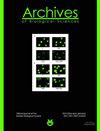水莴苣(Pistia stratiotes L.)在废水中的生长动态模拟
IF 0.8
4区 生物学
Q4 BIOLOGY
引用次数: 0
摘要
本研究旨在评估水莴苣(Pistia stratiotes L.)的生物量增长,在尼斯大学土木工程与建筑学院进行了为期70天的部分控制条件下的测试,测试中使用了公共废水和水力工程示范设施竖井水的混合物作为营养物质来源。70 d后测定的生物量范围为4.31 ~ 4.71 kg WW/m2,平均为4.48 kg WW/m2。日绝对生长率(AGR)为58.81 g/m2 day,日生长率(DIR)为16.16% /day,平均日相对生长率(RGR)为0.0359 g/g day,生物量倍增时间(DT)为32.94 d。采用指数模型(平均MSE 0.0485,平均决定系数(R2) ~ 0.9757)对水生菜生物量生长动态进行建模;logistic模型(均方误差(MSE) 0.0049, R2 0.9976)和s型模型(平均MSE 0.0003,平均R2 0.9999)。所有模型精度高;然而,指数模型给出了生物量随时间的持续增长,几乎达到无穷大,而没有考虑到在植物密度增加和资源可用性降低的情况下,生物量增长会放缓,因此,它们不适合在实际条件下应用。logistic模型(150 d后环境容量6.1680 kg/m2、53.8587 d、32.8295 d、74.8879)和s型模型(150 d后环境容量5.2903 kg/m2、50.2972 d、34.3072 d、66.2872 d)能较好地描述水生菜生长期的生物量增长情况,且精度较高。这对于规划适当的预防和积极措施以控制水莴苣作为入侵植物的传播并尽量减少对塞尔维亚水体的负面影响至关重要。本文章由计算机程序翻译,如有差异,请以英文原文为准。
Modeling the growth dynamics of water lettuce, Pistia stratiotes L. in wastewater
This study was aimed at assessing water lettuce (Pistia stratiotes L.) biomass growth, which was tested at the Faculty of Civil Engineering and Architecture of Nis under partially controlled conditions during a 70-day-long test, with a mixture of communal wastewater and water from the shaft at the hydraulic engineering demonstration facility as a source of nutrient matter. The biomass measured after the 70-day experiment ranged from 4.31 to 4.71 kg WW/m2 (average 4.48 kg WW/m2). The daily absolute growth rate (AGR) was 58.81 g/m2 day, the daily increase rate (DIR) was 16.16 %/day, the average daily relative growth rate (RGR) was 0.0359 g/g day, and the biomass doubling time (DT) was 32.94 days. The following models were used to model the dynamics of water lettuce biomass growth: the exponential model (average MSE 0.0485, average coefficient of determination (R2) to 0.9757); the logistic model (mean squared error (MSE) 0.0049, R2 0.9976), and the sigmoidal model (average MSE 0.0003, average R2 0.9999). All models have a high accuracy; however, the exponential models give a continuous increase in biomass over time, practically to infinity, without taking into account that under conditions of increased plant density and reduced availability of resources, biomass growth slows down and, therefore, they are not suitable for application in real conditions. The logistic model (environmental capacity 6.1680 kg/m2 after about 150 days, ti 53.8587 days, ta 32.8295 days, tb 74.8879), and sigmoidal model (environmental capacity 5.2903 kg/m2 after about 150 days, ti 50.2972 days, ta 34.3072 days, tb 66.2872 days) adequately describe the biomass growth of the growth phase of water lettuce with high precision, which is essential for planning appropriate preventive and active measures to control the spread of water lettuce as an invasive plant and minimize negative impacts on waterbodies in Serbia.
求助全文
通过发布文献求助,成功后即可免费获取论文全文。
去求助
来源期刊
CiteScore
1.40
自引率
0.00%
发文量
25
审稿时长
3-8 weeks
期刊介绍:
The Archives of Biological Sciences is a multidisciplinary journal that covers original research in a wide range of subjects in life science, including biology, ecology, human biology and biomedical research.
The Archives of Biological Sciences features articles in genetics, botany and zoology (including higher and lower terrestrial and aquatic plants and animals, prokaryote biology, algology, mycology, entomology, etc.); biological systematics; evolution; biochemistry, molecular and cell biology, including all aspects of normal cell functioning, from embryonic to differentiated tissues and in different pathological states; physiology, including chronobiology, thermal biology, cryobiology; radiobiology; neurobiology; immunology, including human immunology; human biology, including the biological basis of specific human pathologies and disease management.

 求助内容:
求助内容: 应助结果提醒方式:
应助结果提醒方式:


